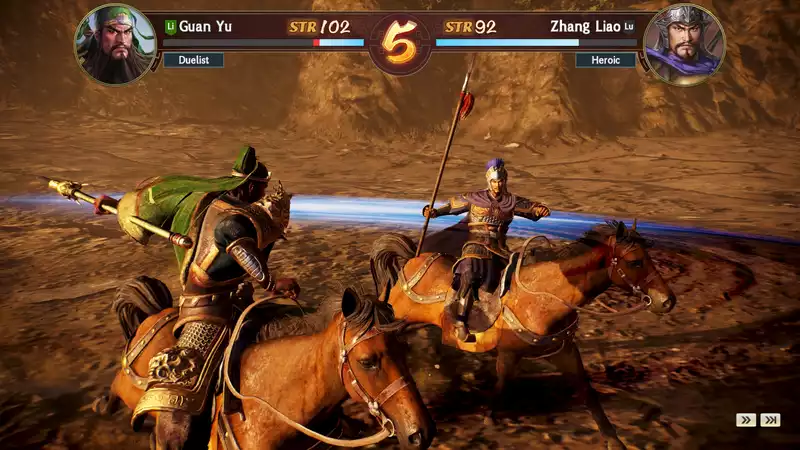For decades, Koei Tecmo has been at the forefront of film adaptations of the semi-historical classic of Chinese literature, The Three Kingdoms. But in the shadow of last year's release of "Total War: The Three Kingdoms," "Three Kingdoms 14" remains a fiddly, underdeveloped attempt to tackle one of China's most famous periods of historical upheaval. It has some interesting ideas, but the poor English localization and tedious combat system prevented me from enjoying it for very long.
The action takes place on a hex-based map covering most of mainland China, and the starting scenario varies greatly depending on which of the eight starting dates you choose. If you want to experience as much conflict as possible, you can jump into 184 AD, the height of the Yellow Turban Rebellion, just as the legendary three brothers, Liu Bei, Guan Yu, and Zhang Fei, pledged their allegiance in the Peach Garden. If you've heard this story before and would like a different one, you can take command in 227, when most of the novel's early powers are dead and the Three Kingdoms are in the midst of a tense struggle.
My favorite addition is a "what if" scenario that presents a hypothetical succession struggle between the clans of the master manipulator Cao Cao that would bring down one of the most powerful factions. While some of the early stages felt a bit underdeveloped, overall I relished the chance to pick up the threads of the story at key turning points, such as the formation of the allied forces against the big bad Dong Zhuo and the pivotal battle of Guandu.
However, these scenarios never truly shined.
It's kind of cool that each state is divided into smaller hexes that can be attacked individually. Also, the placement of small structures like arrow towers and pitfall traps can create clever choke points and turn the tide of an otherwise disastrous battle.
But the battles are mostly tedious. You have some control over what kind of troops you send out, how many dozens of commanders you choose from, what formations and tactics you select, and how much of your limited forces you commit. But once the armies meet on the field, everything is out of your hands and a bit hard to keep up with. Characters automatically use special abilities, which can turn the tide, especially if two or more armies led by generals with strong ties to each other fight together. However, I rarely felt that the decisions I made ahead of time had a significant impact on the battle; even in one-on-one character duels, I would essentially see cutscenes of two people on horseback beating each other until one of them ran out of hit points.
The management of the kingdom is no less thrilling. There are several ministerial positions at the national level that grant overall bonuses for filling them. There are also regional governors and recruiters, who can increase the number of troops you gain each season or help you passively occupy hexes in areas where you already control major settlements. However, I did not usually find them to be interesting trade-offs when building a court. There is often a clear best candidate for each duty, and the only interesting decisions are made when there are not enough officers to fill all the duties and you have to choose which lands to prioritize. Factions are not so differentiated except for the spawn point and the starting pool of officers.
The menus are also a bit cumbersome - at least until you learn what they all mean. The English localization is quite sloppy, making it difficult to find certain important options and information. "Domestics" is a sub-menu for appointing local governors, not the sales department of the mixer. This trend is evident throughout the UI, with many odd word choices that lead to confusion, where clearer alternatives can be quickly found. The same goes for dialogues. As Liu Bei soberly declares in an early mission, "It's good to be strong.
At the very least, the historical heroes and villains are well represented. The advantage of this franchise being so long-running is that dozens of characters, even minor ones, have beautifully animated 2D portraits, 3D models (though sadly they only appear in duels), and carefully selected Characteristics. The art direction is stylish, readable, and exciting. Longtime fans of the Three Kingdoms will not be disappointed to see their old friends and foes in great demand.
I wish I could say the same about the maps, which are decidedly dated. The mountains are boring, low-poly blobs. Most textures are clearly one or two generations old. Lighting is very flat. The graphics options seem to be fully aware of this, with options for "standard," "low," and "lowest."
Conquering China in Three Kingdoms 14 is not a chore. It is just overwhelming. I couldn't think of a compelling reason to play this instead, especially since I've recently seen Creative Assembly do a much better job of representing this period. Only diehard fans of the franchise who want to see Koei's special take on these characters will be excited about this one. And given that this is the 14th in the series, I expected more.
.

Comments